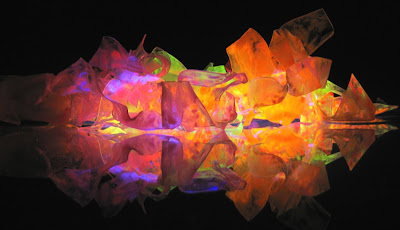The Studio
In our digital era, it is important to review the positon of production and the original. This was the main idea for the studio. The idea of using Surrealism only came natural to the topic, where the purpose was to investigate the possibilities in different types of representation from painting, film and photography.
Walter Benjamin used the word "aura" to refer to the sense of awe and reverence one presumably experienced in the presence of unique works of art. According to Benjamin, this aura inheres not in the object itself but rather in external attributes such as its known line of ownership, its restricted exhibition, its publicized authenticity, or its cultural value. Aura is thus indicative of art's traditional association with primitive, feudal, or bourgeois structures of power and its further association with magic and (religious or secular) ritual. With the advent of art's mechanical reproducibility, and the development of forms of art (such as film) in which there is no actual original, the experience of art could be freed from place and ritual and instead brought under the gaze and control of a mass audience, leading to a shattering of the aura. "For the first time in world history," Benjamin wrote, "mechanical reproduction emancipates the work of art from its parasitical dependence on ritual."
By close-ups of the things around us, by focusing on hidden details of familiar objects, by exploring commonplace milieus under the ingenious guidance of the camera, the film, on the one hand, extends our comprehension of the necessities which rule our lives; on the other hand it manages to assure us of an immense field of action. Our taverns and our metropolitan streets, our offices and our furnished rooms, our railroad stations and our factories appeared to have us locked up hopelessly. Then came the film and burst this prison-world asunder by the dynamite of the tenth of a second, so that now, in the midst of its far-flung ruins and debris, we calmly and adventurously go traveling. With the close-up, space expands; with slow motion, movement is extended. The enlargement of a snapshot does not simply render more precise what in any case was visible though unclear: it reveals entirely new structural formations of the subject. (Walter Benjamin, Illuminations 236)
The concept of “aura,” which is one of Benjamin’s most influential contributions, is best understood in terms of these tensions or oscillations. He says that “aura” is a “strange web of space and time” or “a distance as close as it can be.” The main idea is of something inaccessible and elusive, something highly valued but which is deceptive and out of reach. Aura, in this sense, is associated with the nineteenth century notions of the artwork and is thus lost, Benjamin argues, with the onset of photography. At first photographs attempted to imitate painting but very quickly and because of the nature of the technology photography took its own direction contributing to the destruction of all traditional notions of the fine arts. The stamp and the book are the two images that perhaps best indicate what is at stake. The enigmatic value that a stamp has for the collector is superseded by the more communal and critical value suggested by the knowledge of books, although books too are objects for the collector. Both must be set against the bank-note, which simply circulates in a system of exchange and has no value beyond its system. Finally it is film that is most suggestive for Benjamin.









 Analog Studies
Analog Studies
 Atmosphere
Atmosphere
 Architectural Argument 2
Architectural Argument 2






































